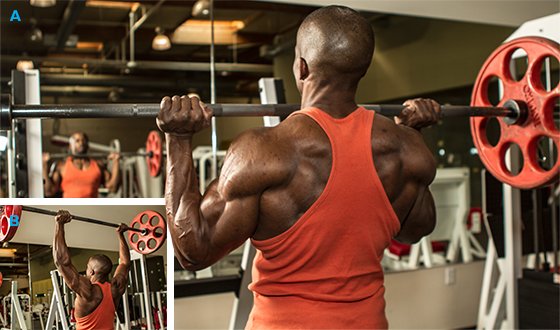Back hyperextension is perhaps the most common issue I see with lifters—and I'm not talking about that exercise you do on a 45-degree bench. Physiologically, back hyperextension happens when someone leans backward while supporting a weight with their upper body. It's difficult to witness because a majority of trainees don't recognize back hyperextension or refuse to admit it exists, so they continue lifting haphazardly. Luckily, there are simple ways to ensure that you don't fall victim to what I call the "carbon monoxide" of strength training.
Overarch, as hyperextension is also known, can lead to major problems and serious discomfort. The most problematic lifts associated with back hyperextension are standing presses and deadlifts, both of which can compress the lower spine. Hyperextension results from different issues in each lift, so it's important to approach each movement with specific solutions.
Here are my best fixes to shield your back from hyperextension attack!
Hyperextension Issues With Standing Presses
Back hyperextension at the top position of a standing press is a widespread practice, and many lifters don't even know it's a problem. However, I often see vertical pushing movements compress the spine and expose the lumbar region to hyperextension, which subsequently puts the discs in a vulnerable situation.

Standing Press
One reason for spinal compression during a press is because of insufficient shoulder mobility. The ideal top position for a standing press is when the bar is directly over the spine, not in front your body. When you try to force your arms into an overhead position without the range of motion (ROM) available to do so, something will give. The back compensates by overarching to let the ribcage shift backward and assist the arms into the added degrees of motion.
Hyperextension can also loosen the lower abs, which lessens the abdominal activity required to safely complete the lift. This chain reaction can be best avoided by improving shoulder and hip mobility.
The Fix: Shoulder "Dislocates"
A good dynamic way to increase ROM at the shoulder and work on circumduction is to use shoulder dislocates. These are performed by grabbing a broomstick or dowel and holding it with straight elbows, placing one hand at each end.
With your arms straight, perform a full revolution from the front to the back of the body, making sure the dowel is against your back or butt in the finish position. Return to the starting position. Repeat and slowly inch your hands inward on the dowel as your mobility increases. Perform this warm-up prior to every pressing workout and do as many revolutions as it takes to see mobility improvement.
Hyperextension Issues With Deadlifts
The deadlift is a more complex movement than a standing press because the pelvis position is more sensitive to what muscles are used, and when. A good deadlift setup requires a solid lower back arch that tightens the posterior chain and readies it to peel a heavy bar off the floor.
In the setup, the lower back has control of the pelvis. The tricky part comes when the bar starts to move. This is when overarch and back dominance comes into play. A good deadlift requires pelvis control that takes over for the lower back partway through the lift, which allows the glutes and hamstrings to fully extend the hips.
Check out these videos that show incorrect and correct deadlift execution so you can recognize back hyperextension:
Incorrect deadlift execution:
Correct Deadlift Execution:
The Fix: Psoas Glute Bridges
Psoas glute bridges or single-leg hip thrusts help the glutes overcome anterior tilt and promote proper hip extension. Place a tennis ball in the hip fold of the elevated leg, extend the hips by pressing through the heel of the planted leg, strive for the greatest ROM possible, and never quit squeezing the ball with your hip.
I recommend performing psoas glute bridges as a standalone exercise because of their difficulty. Doing them in straight sets as part of your workout creates a beneficial tool to help glute function and pelvic control. Perform 3-4 sets of 10-12 reps per leg at the beginning of your workout before the targeted muscles become fatigued.
Double the Fix: Dead Bugs
Dead bugs simultaneously address the effects that weak or inactive lower abdominals have on overhead presses and deadlifts. Lower abdominal involvement counters overarch and forward pelvic tilt. Dead bugs can increase core activation, promote proper diaphragmatic breathing patterns, and improve force transfer from the lower to upper body.
To perform a dead bug, lie on your back with your arms held up against a wall just shy of lockout. Bend the knees and keep the feet and lower legs parallel to the floor, which looks like you're sitting on a chair, but on your back. Press hard into the wall and remove the space from underneath the lower back while maintaining pressure. Slowly perform "footsteps" by lowering the heels to the floor in an alternating fashion.
Paying attention to all the cues at the same time isn't easy, so 30 "steps" should feel like hard work. If you're deadlifing or pressing submaximal loads under 80 percent of your one-rep max, then this is a good exercise to sprinkle in as a filler movement to assist your subsequent exercises.
